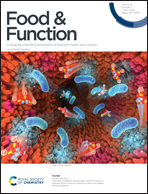Molecular docking and in vivo protective effects of okra (Abelmoschus esculentus) against metabolic dysfunction in high-fat, high-sodium diet-fed rats
Abstract
Okra pods (Abelmoschus esculentus L. Moench) have been used as a functional vegetable as they contain polysaccharides, flavonoids, and other bioactive molecules that protect the body from several chronic diseases. The purpose of this study was to look at the involvement of okra constituents (mucilage and flesh) in the prevention of metabolic dysfunctions induced in a rat model by a high-fat, high-salt (HF/NaCl) diet. Okra mucilage was extracted using an ultrasonic method, freeze-dried, characterized using Fourier transform infrared (FTIR) and scanning electron microscopy (SEM), and tested for swelling ratio and radical scavenging activity. Okra flesh (skin and seeds) was separated from pods; characterized using SEM; and tested for dietary fiber content, phenolic profile, and radical scavenging activity. The significance of okra bioactive compounds in inhibiting human salivary amylase, glutamine : fructose-6-phosphate amidotransferase (GFAT), tumor necrosis factor-alpha (TNF-α), and C-reactive protein (CRP) was investigated using molecular docking. Rats were fed an HF/NaCl diet and orally treated daily with freeze-dried okra mucilage or flesh (100 mg per kg body weight) for 8 weeks. Glucose, insulin, inflammatory indicators (CRP, TNF-α, and interleukin 6), oxidative markers (red blood cell lipid peroxidation, glutathione peroxidase, nitric oxide, and superoxide dismutase), lipid profile, estradiol, feces lipids as well as femur and urine calcium were measured. The molecular docking findings showed the interaction of quercetin and chlorogenic acid, which are the most abundant phenolic compounds in okra pods, with the studied proteins, which gives an indication of the mechanism of okra's anti-diabetic, anti-oxidant, and anti-inflammatory effects. Okra mucilage and flesh significantly reduced glucose, insulin, cholesterol, lipid peroxidation, CRP, TNF-α, IL-6, and urine calcium levels while significantly increasing feces lipid and femur calcium levels. The findings suggested that okra mucilage and flesh seem to be promising candidates for protection against metabolic dysfunction.



 Please wait while we load your content...
Please wait while we load your content...